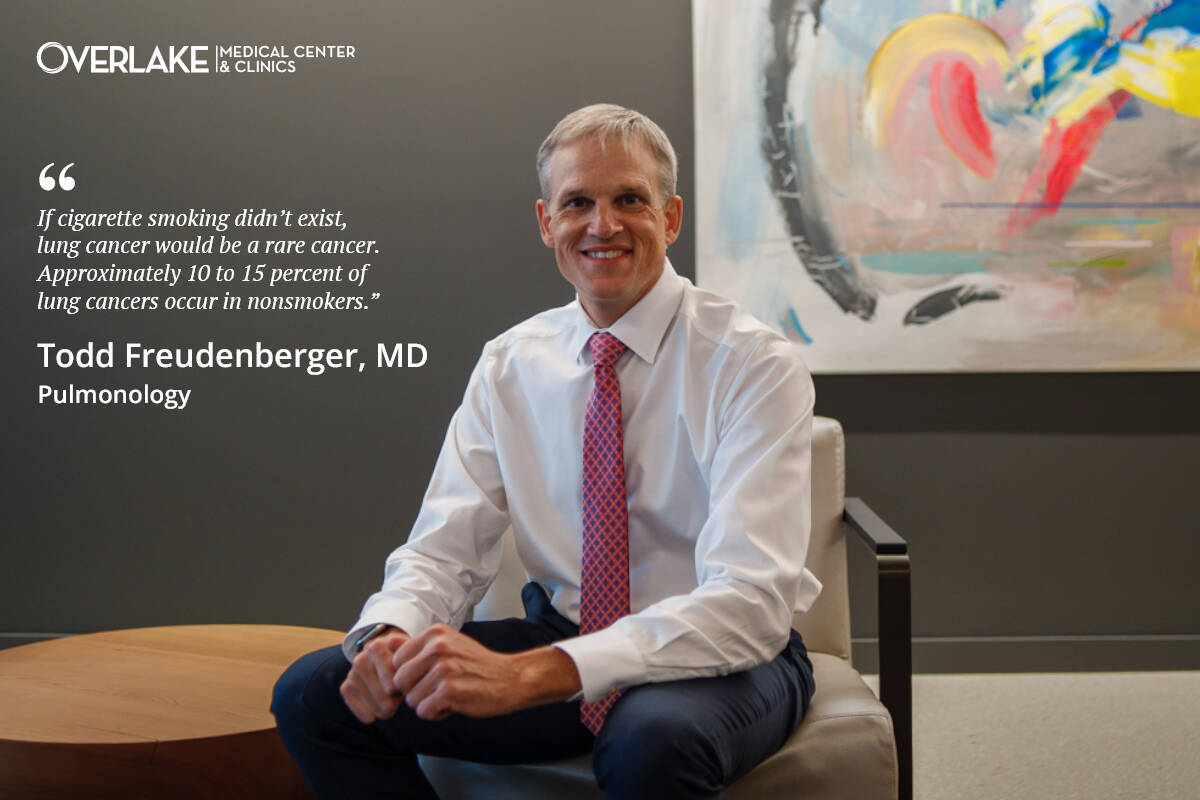Not all cancers are the same. Treatment options vary, depending on how a cancer behaves in the body and how much researchers understand about the way it functions.
“Some cancers are exquisitely sensitive to a range of treatments including chemotherapy, immunotherapy, designer drug therapy and radiation. Although responsive, lung cancer is rarely cured with one of these approaches alone. We almost always have to surgically remove it,” says Todd D. Freudenberger, MD, pulmonologist at Overlake Medical Center & Clinics in Bellevue. “If we find lung cancer early there is a good chance for a surgical cure. If we find it late, surgery is no longer an option.”
Often patients don’t notice symptoms of lung cancer — it’s only when the cancer has metastasized to another part of the body that symptoms present themselves. That’s why regular screening for high risk patients is so important.
Who is at risk?
“If cigarette smoking didn’t exist, lung cancer would be a rare cancer. Approximately 10 to 15 percent of lung cancers occur in nonsmokers,” Dr. Freudenberger says.
People at the highest risk for lung cancer are between the ages of 50 and 80 with a tobacco smoking history of at least 20 pack-years (one pack-year is equal to smoking one pack per day for one year) and who are still smoking or have quit within the last 15 years.
“After 15 years, your risk of lung cancer is similar to that of someone who has never smoked.”
Who should be screened for lung cancer, and how often?
Those at highest risk (between ages 50-80, at least 20 pack-years, and have smoked within the last 15 years) should be screened with a low-dose CT scan once every year until they no longer meet the criteria for high risk.
“It’s been a bit of a moving target over recent years. Current guidelines are based on advances in testing, and most commercial insurance providers are now aligning over the guidelines shared by Medicare,” Dr. Freudenberger says.
Screening is recommended for asymptomatic patients, and no one should be afraid to seek evaluation and care. Medical professionals are here to help, regardless of your lifestyle.
How can you reduce your risk?
The most effective way to reduce your risk of lung cancer is to quit smoking. But even if you’re not ready to quit, building a strong relationship with your primary care physician is important.
“Many smokers feel there’s a stigma to being a smoker and hesitate to seek medical care. Some think any symptoms they’re experiencing are their own fault, others assume their physician’s only advice will be to tell them to quit smoking,” Dr. Freudenberger says. “While lifestyle changes are ideal, we want to help you with your current issues as well, whatever you’re experiencing,”
A new or worsening cough, a change in sputum production (lung mucus) or blood in sputum, chest pain, fever, sweats and weight loss may all be signs of lung cancer.
“These symptoms can be caused by many things, but it’s important to investigate.”
When you’re ready, your doctor can also help you quit smoking. If you’re using vaping or other tools to stop smoking, make sure you work with primary care physician on a plan to be successful.
Talk to your doctor to schedule lung cancer screening today. Should the screening reveal lung cancer, the Overlake Cancer Center provides the latest and most technologically advanced methods of treatment at 1135 116th Ave NE, Suite 200 in Bellevue.



